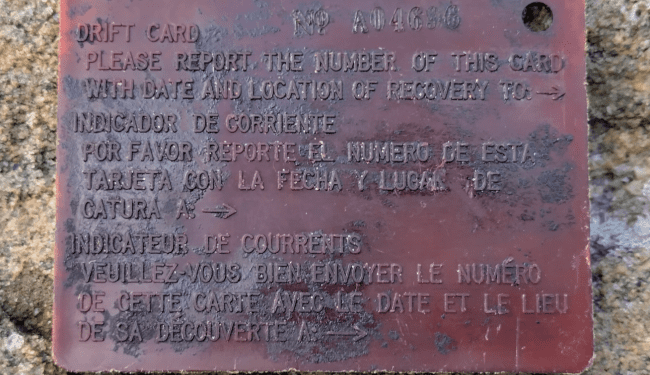Isle of Coll, Scotland (LOOTPRESS) – Barbara Payne, a longtime resident of the Isle of Coll off Scotland’s coast, made a remarkable discovery while cleaning debris left by a storm. Amid the seaweed and plastic litter, Payne found a small, red, credit card-sized piece of plastic with instructions in English, French, and Spanish to report its find to NOAA (National Oceanic and Atmospheric Administration) in Boulder, Colorado.
A Historical Find
A quick online search led Payne to NOAA’s Office of Response and Restoration (OR&R), where she learned the card was part of a 1976 effort to track ocean currents after one of the largest oil spills in U.S. history. These “drift cards” were released into the Atlantic following the Argo Merchant oil spill to study oil movement in ocean currents.
The Argo Merchant, a 640-foot tanker, ran aground off the coast of Nantucket Island, Massachusetts, on December 15, 1976, spilling 7.5 million gallons of oil into the North Atlantic. The drift cards, intentionally designed to mimic floating oil, helped researchers understand how currents would carry spilled oil and the potential environmental impact.
The Story Behind the Spill
The Argo Merchant spill occurred during a critical period in U.S. energy history. Following the 1973 oil embargo, offshore oil exploration and environmental assessments intensified, leading to the creation of NOAA’s Spilled Oil Research Team. This group, a precursor to today’s OR&R, played a pivotal role in the Argo Merchant response.
The spill, at the time the largest in U.S. history, highlighted the environmental risks associated with single-hull tankers and spurred advancements in oil spill modeling and response. NOAA’s modern GNOME (General NOAA Operational Modeling Environment) spill modeling tools trace their origins to studies conducted during this event.
A Journey Across the Atlantic
Payne’s discovery underscores the longevity of plastic in marine environments. Drift cards, such as the one Payne found, were historically made of plastic but are now replaced with biodegradable alternatives to minimize environmental harm.
The Gulf Stream, part of the North Atlantic Gyre, likely carried the drift card from the United States across the Atlantic. Ocean currents and storms may have pushed it ashore and back to sea multiple times over nearly five decades before it finally landed on the Isle of Coll.
A Timeless Reminder
Barbara’s find offers a sobering reminder of plastic’s persistence in the environment. While the oil from the Argo Merchant spill has long degraded and dissipated, the drift card serves as a small time capsule from 1976. It also highlights the evolution of NOAA’s oil spill response and the enduring problem of plastic pollution in our oceans.
The drift card, which began its journey on December 27, 1976, and ended on Payne’s beach in 2024, symbolizes both the advances in environmental science and the challenges that remain. NOAA’s work in pollution response continues to build on lessons learned from incidents like the Argo Merchant spill, striving to better protect marine ecosystems and coastal communities.











